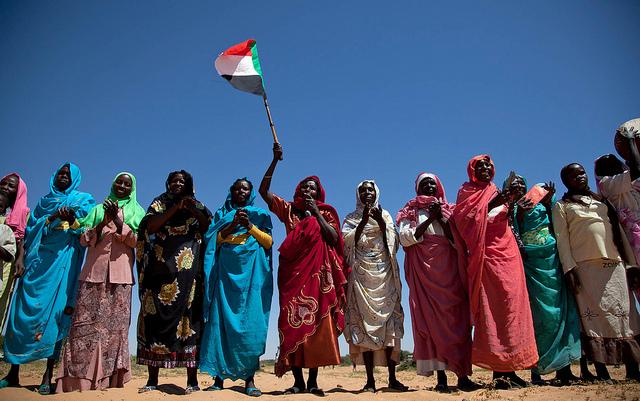
This month, United Nations Security Council Resolution 1325 on Women, Peace and Security turns 15. But what has changed for women and girls in conflict over the past decade and a half?
Nearly 300 schoolgirls from Chibok Government Secondary School are still missing, joining another 2,000 women and girls who have been kidnapped by Boko Haram since 2014. And thousands of women, teenage girls and boys are still enslaved by Islamic State (IS), many as sex slaves.
According to the United Nations, sexual violence in conflict is one of the greatest moral issues of our time. It’s a moral issue we face now and it has been a moral issue for time immemorial.
Lamentations recount that ‘women have been ravished in Zion, and virgins in the towns of Judah’. Historically, rape was characterised as a private crime against a woman’s honour and not a matter of universal human rights.
During World War II, the Japanese created ‘comfort women’ and the Soviet army is thought to have raped up to two million women in Eastern Europe and Germany. Despite the fact that evidence of sexual atrocities was received by the Nuremberg tribunal, those who committed these crimes were never prosecuted for them.
On the other hand, indictments before the Tokyo tribunal did charge rape and received evidence, and the Tokyo judgement referred to rape. General Matsui was convicted of war crimes as well as crimes against humanity based in part on evidence of rape. However, none of the victims were called to testify and the issue was only given incidental attention.
In June 1996, the International Criminal Tribunal for the former Yugoslavia issued its first indictment that dealt exclusively with sexual violence and adopted rules that made it easier for victims to give evidence. The tribunal represented a watershed moment for sexual violence in conflict and it’s now a regular aspect of the United Nations’ work.
And this year, more progress: the Government of Croatia passed a new bill to compensate victims of sexual violence, the African Union committed to a landmark framework on cooperation with the United Nations on the prevention of sexual violence, the Sudan People’s Liberation Movement/Sudan People’s Liberation Army In Opposition committed to prevent conflict-related sexual violence and the armed forces of the Democratic Republic of Congo signed a declaration to combat rape in war.
Yet the abuse and atrocities against women and girls in conflict continues. It’s horrifying to contemplate that in the 21st century the use of sexual violence as a weapon of war, as an orchestrated, industrialised terror tactic is still part of the terrain of conflict. To date, the focus on eliminating and prosecuting sexual violence in conflict has been on state actors.
How do we broker agreements with non-state actors who haven’t signed up to international norms, laws, conventions, protocols or rules of engagement? Those groups’ strategies are to shock, defile and denigrate all that we hold sacred and whose very tactic is to affront our morality and challenge our values.
What we are seeing with IS is a non-state actor engaging in some of the most unspeakable acts of sexual violence, where rape and sexual abuse aren’t just a by-product of war but used as a deliberate military strategy to degrade the enemy, guided by a pamphlet chillingly entitled ‘Questions and Answers on Taking Captives and Slaves’.
The UN’s Special Representative to the Secretary-General on Sexual Violence in Conflict, Zainab Bangura, found that girls from Iraq and Syria had been stripped, sold, and in some cases, made to undergo over a dozen virginity reparation surgeries. The intense shame that accompanies these acts is too much for many women to bear, with a number later committing suicide—as suggested in this horrifying message from IS fighter Abou Jihad:
‘Yes… they are idolators, so it’s normal that they are slaves, in Mosul they are closed in a room and cry, and one of them committed suicide LOL’
How we deal with this entrenched hatred of women will challenge us for years. While the United Nations, through UNSC1325, the supporting resolutions and the Special Representative to the Secretary-General on Sexual Violence in Conflict, has made some progress in achieving its goals and milestones, much more needs to be done.
Today, the UNSCR1325 will undergo a high level review. And it’s vital the review takes a close, long and hard look at Item 10, which ‘Calls on all parties to armed conflict to take special measures to protect women and girls from gender-based violence, particularly rape and other forms of sexual abuse, and all other forms of violence in situations of armed conflict.’
A lot has changed in the geostrategic environment in 15 years. UNSCR1325 pre-dates 9/11, Afghanistan, Iraq, Syria, Libya, Ukraine, Sudan, the Arab Spring and the emergence of Boko Haram, IS and al-Qaeda. It pre-dates the violation and torture of women and children through rape, prostitution and sexual slavery by non-state actors. And it pre-dates the establishment of the Special Representative to the Secretary-General on Sexual Violence in Conflict.
The review provides the opportunity to re-examine and recast UNSCR1325 in today’s world of violent extremism, social media and non-state actors operating outside traditional paradigms.
To gain a steely resolve to act upon, not just talk about, the institutionalised sexual violence of women and children as a central aspect of ideology and operations and a tactic of terrorism.
And to address the nub of the issue – the complex and challenging task of gender equality.
So that women are not only around the table in post-conflict and peace negotiations. But in the leadership positions to help avoid conflict in the first place.